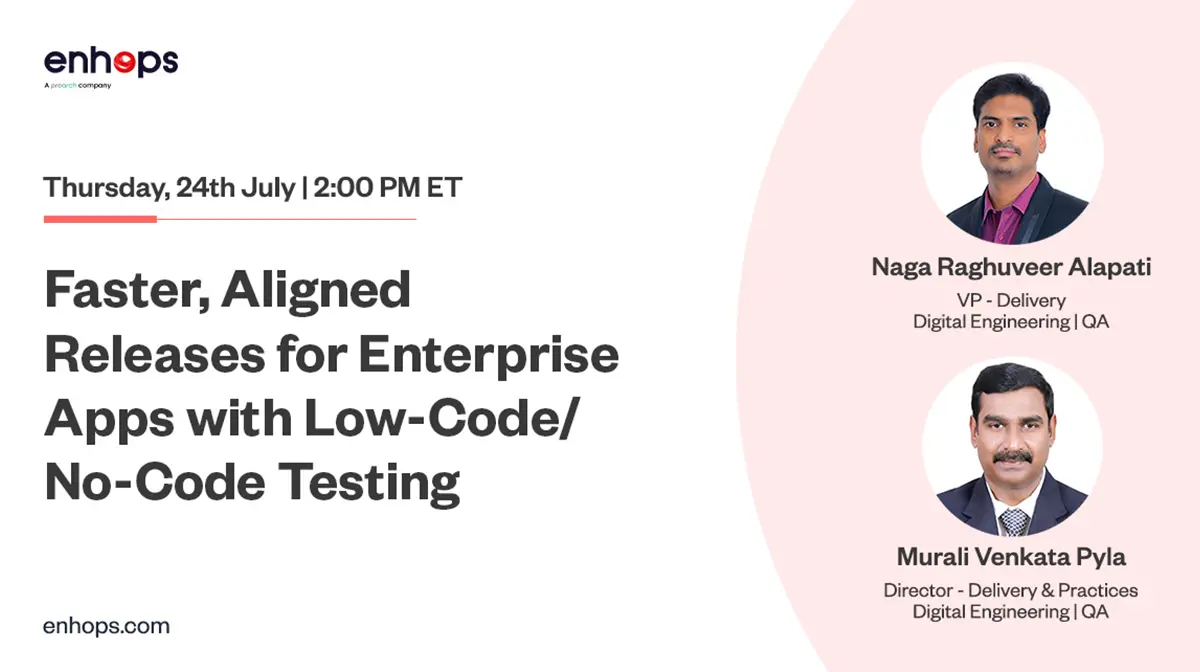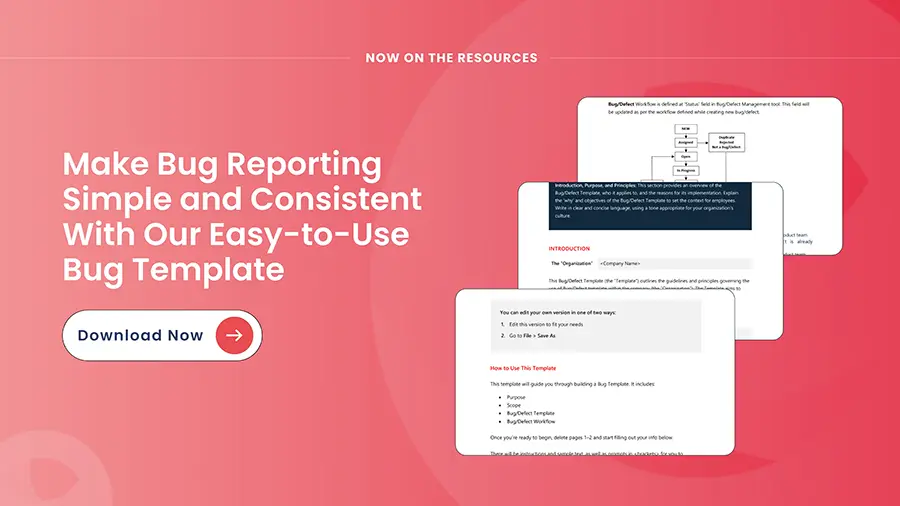The world is in a state of continuous digital disruption. The World Economic Forum says we are in the Fourth Industrial Revolution, where AI has been an integral part for human survival. Carlota Perez thinks that we are going to enter the Fifth Industrial Revolution – the precipice of a Golden Age.
Organizations all over the world are transitioning from traditional software development ways to agile and DevOps style of working. While there are number of tools, technologies, best practices, and methodologies to make this transition effortless, they are all finding it’s a constant race to keep up. It takes time and effort to evolve software development practices and with continuous push and demands from customers, it all comes down to how much quality you are providing and how much value you are generating for your customers.
The old definition of quality has changed. Quality of an application doesn’t revolve around the ability to finish a given task, but it encompasses lot of things like – scalability, composability, interoperability, performance under high stress and load conditions, seamless integrations. Organizations and development teams need to unlearn behaviours and practices around quality engineering.
It is the time companies think about Gen Z and Gen Alpha in building products and deliver quality accordingly.These are the generations that are born in technology world and know every beat of it. Unlike their counterparts, they know their options very well and are less loyal. If you can’t keep up with them, you are very likely to extinct in another 20 years.
And to keep up pace with their expectations, quality cannot be an afterthought. This is where Quality 4.0 comes in.
What is Quality 4.0?
To understand what Quality 4.0 is, we will first understand Industry 4.0.
Industry 4.0 is the implementation of advanced and new-age technologies to drive the next phase of digital transformation. This involves proficient use of technologies like AI-ML and their subsets, Cloud Computing, Internet of Things, Edge Computing, Cybersecurity, and Digital Twins.
The recent successful use cases of Chat GPT3, Metaverse, Digital Manufacturing, etc. showcases how we are moving towards full adoption of Industry 4.0.
Drawing inference from here, Quality 4.0 is the new age Quality Engineering practices that are needed to build applications, products, and services in Industry 4.0. The old practices of quality engineering will not be able to match the pace with industry 4.0 applications and products.
Summarizing the above, Quality 4.0 are the new-age technologies and practices required to keep up the quality assurance, testing, quality engineering, and quality by design in the evolved world of technology. These new Quality 4.0 practices are built using Data, AI-ML and Deep Learning, Cloud and Edge Computing solutions, and Cybersecurity.
How Quality 4.0 is different from traditional Quality Engineering?
Quality Assurance (QA) and Quality Engineering 4.0 are related but Quality Engineering 4.0 is a much more evolved version of traditional quality practices. While quality assurance is a process-oriented approach and usually executed at the end of the software development lifecycle, quality engineering is a technology-oriented approach where quality is thought as the first step in development lifecycle. Various measures are put in place to achieve quality 4.0 mindset and practices across the organization.
| Parameter | Quality Assurance | Quality Engineering 4.0 |
| Approach | Process-Oriented Approach | Technology Oriented Approach |
| Mindset | Get the testing done mindset | Deliver the quality that enhances customer experience |
| Leadership Involvement | At a surface level | Need to be involved completely |
| Culture | Follows Waterfall Culture | Follows Agile and DevOps Culture |
| Typical Processes | Inspecting, testing, and auditing products to ensure compliance with regulations and industry standards | Involves multiple processes like Continuous Testing, CI-CD, DevTestOps, DevSecOps, Agile Testing, using AI and ML in testing and Cybersecurity Testing tools |
| Technologies | Manual and Test Automation, Performance Testing, Test Environment Management, Test Data Management, Bug tracking tool | Data Management, Advanced Analytics, Predictive QA, Virtual and Augmented Testing, Cybersecurity, and more |
| End-Goal | Defect free software meeting the business requirements | Provide exceptional user experience to customers every time |
In summary, QA is more about looking for defects and ensuring compliance, while QE 4.0 is more about optimizing product quality and production processes. QA is more of a reactive approach, while QE 4.0 is more of a proactive approach. QA is mainly focused on conformance to standards, while QE 4.0 is focused on continuous improvement and innovation.
Quality 4.0 – An Industry Approved Framework
Research and studies have confirmed that Quality 4.0 is much more than investing and implementing in advanced technologies. The success of embedding Quality 4.0 throughout the organization depends on organizational leadership, culture, processes, and technology.
Organizational Leadership –Quality Engineering 4.0 requires cultural change and risk-taking approach in experimenting with new technologies and streamlining processes. Leadership and their vision of improving quality across organization can help in instilling a culture of continuous improvement and innovation that is essential for staying competitive in the rapidly changing business environment of Industry 4.0.
Without bold and risk-taking leadership, organizations would get stuck in outdated and inefficient processes. For adopting Quality Engineering 4.0, risk taking can include understanding and adopting new technologies such as artificial intelligence, machine learning, and advanced analytics.
Caution – It’s important to take risks with strong risk management strategy. This minimizes the negative impact of any failures and gives a sense of direction to teams. To create a strong risk management strategy, identify the potential risks, assess their likelihood and impact, and put on effective controls to avoid or mitigate them. Have a bounce back strategy in place too.
Cultural Change – Quality Engineering 4.0 requires strong cultural change for organizations to fully realize benefits of new technologies and processes. To stay ahead of the competition, a culture of continuous improvement and learning has to be fostered. A culture of continuous learning and improvement enables employees to try their hands of various solutions and bring out the tried and tested best practices without any fear.
Additionally, Quality Engineering 4.0 relies heavily on data, analytics, and metrics. Leaders should ensure that everyone understands that data-driven decision making can enable business to have realistic expectations and work on the areas where business is lagging.
Caution: Don’t leave your cultural change to emails and communications. Implementing cultural change requires the active involvement from leadership. They must participate actively and identify culture champions within the organization to drive it to the root level effectively.
Processes – Quality Engineering 4.0 requires new age tools and processes like test automation, shift-left and shift-right testing, DevTestOps, DevSecOps, CI-CD, SDETs, Test Driven Development and Behavior Driven Development along with AI-ML and Data Models.
To establish Quality Engineering 4.0 processes, organizations must take a multi-pronged approach that includes analysis of current quality practices, implementing and adopting new technologies, training employees in new processes and technologies. Based on the thorough quality assessment, organizations can work with specialized Quality Engineering services provider to implement new technologies and processes.
Post that, they must continuously monitor and measure the performance of new processes and technologies using data analytics and other tools to identify improvement areas and adjust as necessary.
Caution: Establishing processes in Quality Engineering 4.0 is not a one-time process, it requires continuous improvements and innovations to realize complete returns on investment.
Technology – Quality Engineering 4.0 needs new age testing tools and processes that can help in improving the overall product quality, identify defects at an early stage, open pathways for simulated and virtual testing using exploratory testing methods. As organizations will start implementing AI-Ml and Data models in their testing processes, predictive maintenance will see rise and testing will be integrated from the day zero in the software development lifecycle.
Some of the technologies that will gain more foothold with the rise of Quality Engineering 4.0 are Continuous Testing tools, Virtual Reality and Augmented Reality testing tools, emulators and simulators, and automation testing tools like Selenium, Appium, and Test Complete.
Caution: With technologies becoming affordable and democratized, it’s only the continuous innovation that will set organizations apart from competitors. Work with your partners and clients to provide innovative, scalable, and cost-effective solutions. This will help you in achieving the true goals of Quality Engineering 4.0.
Implementing Quality 4.0 Framework in your organization
Every organization’s journey towards implementing Quality 4.0 can be different and full of learnings. To start your quality 4.0 journey, assess your current quality state in terms of manual and automated testing, test coverages, in-house testing skills and budget, improvement in quality assurance practices in one year and start working with your team to visualize goals.
Once you have a thorough outline of your current quality engineering practice, start pinpointing the bottlenecks and plans for improvement. You can choose to work with specialized quality engineering partners like Enhops who has implemented and paved way for quality 4.0 in multiple organization.
Your action plan must include new tools and technologies, current skillsets in organization, learning curve, PoC details and metrics to start implementing the quality framework. Once the full-blown implementation starts, monitor, and measure the effectiveness by collecting quality metrics and use them to make improvements as needed. Continuously review and improve the Quality Engineering 4.0 processes and technologies to ensure that they remain up-to-date and effective.
Enhops offers Smart Quality Engineering solutions and acts as strategic partners to organizations of all sizes – starting from start-ups to Fortune 500/100 organizations to elevate their quality engineering programs. Interested in a free PoC, write to us at info@enhops.com.




